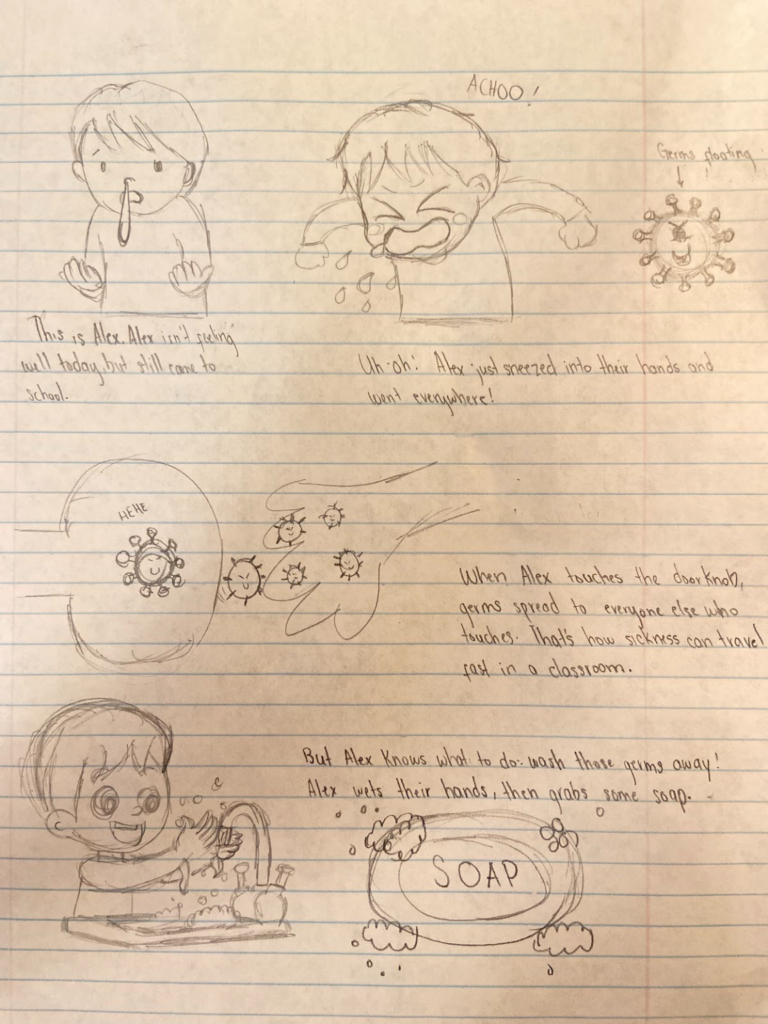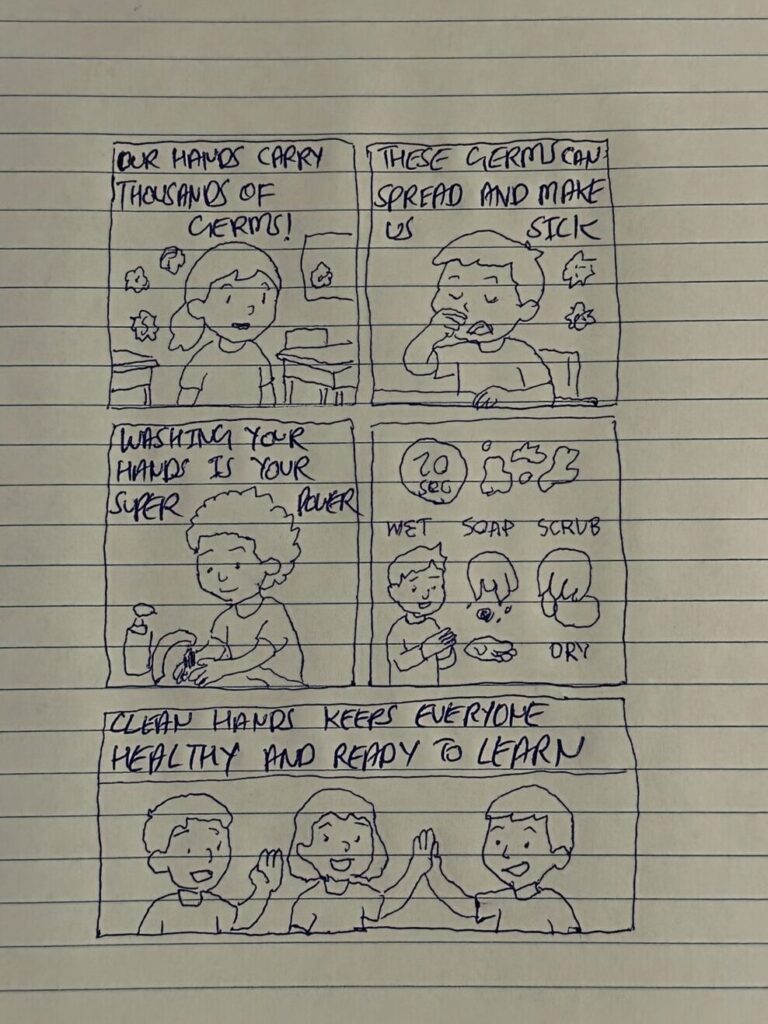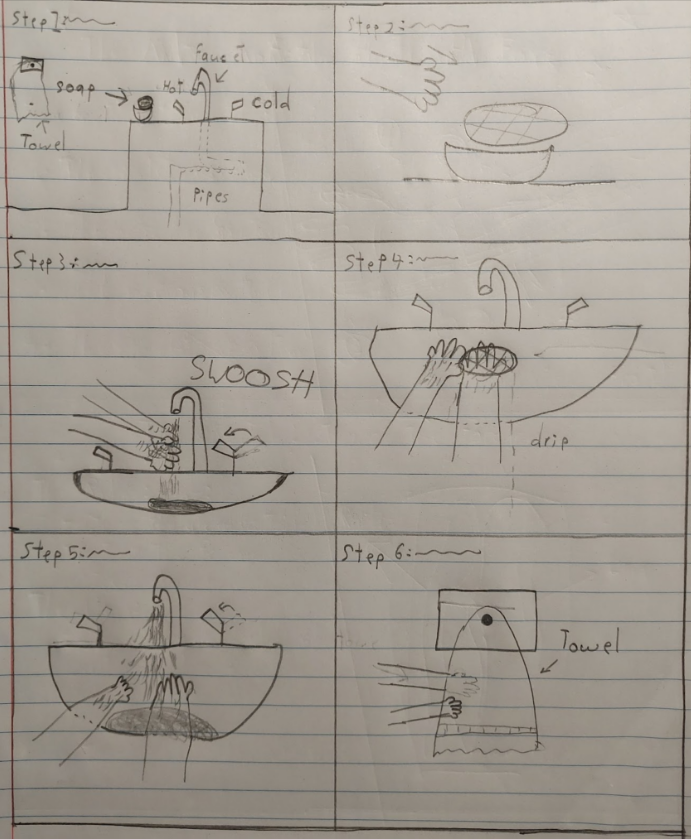Stop the Spread, Wash Your Hands Right!
Updated: October 9, 2025
Authors: Raj Aarya, Bashar Kabd, & Therese Taruc
This blog post is a documentation of the process we underwent to create three 1-minute videos about our topic. This learning pod is composed of three members: Bashar Kabd, Raj Aarya, and Therese Taruc. We chose this topic because we were all familiar with it from a young age, and we wanted to explore hand hygiene in more detail as part of our project. Our goal is to expand our knowledge about the topic by explaining it in a quick and concise way. Overall, we are excited to see what we find, and how our videos turn out in the end.
THE PROCESS
Understand (Discover, Interpret, Specify)
DESCRIBE THE CHALLENGE:
Elementary school children need to learn the importance of proper handwashing techniques to protect themselves and others from spreading germs and illnesses. This helps them stay healthy, reduce the spread of illness and diseases, and they feel confident in taking responsibility for their hygiene.
CONTEXT AND AUDIENCE:

Audience
A typical audience is made up of elementary-school students (aged 5-12 years old). Students will be able to watch the video as part of class assignments or in-class activities and possibly as part of a guest speakers activity. Some extreme audience cases include students with learning difficulties, as well as visual or auditory problems.
Needs
Elementary school students completing this assignment or activity will need to watch over the videos and demonstrate their ability to wash their hands from start to finish. For students with hearing problems, the video can be uploaded to youtube, and captions can be shown. For students with sight problems, the guest speaker or teacher can provide the students with a verbal description of certain steps, as well as help the student practice hand washing. For students with learning difficulties, the task can be broken down into smaller and easy to digest steps, and explained in a simplified way.
Photo By: Sandra Seitamaa on Unsplash
Goals
The goal for the students is to complete the assignment or activity and learn how to wash their hands at the bathroom sink without assistance. This will help them develop better hygienic habits, reduce likelihood of sickness, and stay clean. Moreover, the elementary schoolers will get closer to their classmates as they learn to wash their hands together during the activity.
Motivations
Students will feel motivated to complete the assignments for a handful of reasons. The first is that the videos will be designed to be appealing to elementary-schoolers. There will be colorful graphics and simple narration. The second reason is that students will enjoy completing the activity with their friends.
POV STATEMENT:
An elementary school student needs to learn healthy handwashing habits through clear, step-by-step instructions so they can stay healthy, prevent the spread of germs, protect both themselves and their friends, and promote a clean, healthy classroom environment.
LEARNING OBJECTIVES:
Primary Objectives
1. Healthy habits
- Students will learn when handwashing is necessary (e.g., before eating, after bathroom use, after coughing/sneezing)
- Students can follow clear, step-by-step instructions to wash their hands correctly
2. Health awareness
- Students will understand the importance of handwashing to prevent the spread of germs and illnesses
- Students can recognize how personal hygiene affects their both their health and the health of their classmates
Sub-Objectives
- Students can feel motivated to wash hands regularly because the activity is presented in a fun and engaging way
- Students can develop a positive attitude towards personal hygiene and incorporate their hand hygiene even outside of the classroom thereby promoting lifelong healthy practices
Photo By: Katelyn Perry on Unsplash

Plan (Ideate, Sketch, Elaborate)
IDEATION:
The main objective of the brainstorming stage was to find different types of methods through which we can make the concept of hand hygiene both easy to understand and visually engaging for the students in elementary school. We found various resources highlighting the importance of handwashing practice, but the ones that stood out to us were the Centers for Disease Control and Prevention (CDC) and the World Health Organization (WHO), which provided the foundation for proper handwashing steps. Other than written resources, we dove into the educational short videos designed for the children, as well as the posters and charts in the classrooms on the topic of hand hygiene. These resources highlighted effective strategies, such as colorful visuals and demonstrations, while avoiding common mistakes like overloading information or using technical terms that are hard to understand.
From this process emerged three potential prototypes:
- Instructional video: a short and straightforward video/tutorial teaching the correct handwashing techniques to students.
- Scenario-based vide: a short story with the main character in the centre explaining the importance of hand hygiene.
- Explanatory Video: a small approach with animations and playful script, which explains why hand-washing matters by visually showing germs, and each step will come with narration and adequate visual cues.
The most promising prototype that we found is the explanatory video, because this type of video is the combination of engaging visuals and narration, with clear step-by-step information that makes the information easy to understand. This approach also reinforces the importance of hand-washing practice with clear guidelines, helping to build understanding and motivation among elementary school students.
(SCENARIO): “Alex and Handwashing”
SCRIPT
Sniffly and sick Alex
Narrator: “This is Alex. Alex isn’t feeling very well today, but still came to school.”
Alex sneezes into his hand
Narrator: “Uh oh! Alex just sneezed into their hands!”
Alex touches a doorknob and germs can be seen attaching
Narrator: “When Alex touches the doorknob, germs spread to everyone else who touches it. That’s how sickness can travel fast in a classroom.”
Alex at sink doing step-by-step handwashing at the sink on a chair (maybe he’s small)
Narrator: “But Alex knows what to do: wash those germs away! Alex, wets his hands then adds some soap. He scrubs the soap all over his hands. Palms, back of hands, between fingers, and even under his nails. After scrubbing well, Alex rinses off all the bubbles with clean water. Finally, Alex turns off the tap and dries his hands with a fresh towel.”
Alex in classroom with other students
Narrator: “Now Alex’s hands are squeaky clean! By washing your hands, you protect yourself and your classmates, which helps everyone stay healthy and enjoy a safe, happy classroom.”
STORYBOARD


(EXPLANATORY): “The Power of Clean Hands!”
SCRIPT & STORYBOARD
Scene 1 – The Background is a classroom; animated germs are moving around in the space above the children. Narrator: “Did you know that our hands can carry thousands of invisible germs? They travel with us everywhere—on doorknobs, desks, and even our phones!”
Scene 2– one of the students starts sneezing and touching the desk. Narrator: “When we don’t wash our hands, these germs can spread and make us or others sick.”
Scene 3- Then the child stands up and goes to the sink. Narrator: “But washing your hands properly is like having a superpower—it can stop germs in their tracks!”
Scene 4- an animated picture/chart comes up showing 5 steps of hand washing: Wet – Soap – Scrub – Rinse – Dry. Narrator: “Just wet your hands, add soap, scrub for 20 seconds, rinse well, and dry completely.”
Scene 5- students in the classroom feel happy and start high-fiving each other. Narrator: “Clean hands keep everyone healthy, happy, and ready to learn!”

(HOW-TO): “How to Wash Your Hands: a Tutorial”
SCRIPT & STORYBOARD
Step 1: Approach the nearest sink (with soap and running water available)
Step 2: Grab the soap
Step 3: Wet your hands
Step 4: Rub soap all over your hands
Step 5: Run water over your hand until there is no more soap
Step 6: Dry your hands with a towel

PRINCIPLES APPLIED:
Coherence and Signaling Principle
We used coherence principle to guide and ensure that each video avoided unnecessary information, sounds, and visuals so that the view can focus on the key message. In Alex and Handwashing, only relevant narration and simple animations are included, while avoiding background distractions. In one of the scenes, it is shown that the hand washing techniques are numbered thereby applying the signaling principles to guide the viewer the proper correct sequence of handwashing actions. By maintaining coherence and using clear signals such as the visual cues, these can support learners in processing information in a clear, structured manner where the viewer’s cognitive process and extraneous load is reduced and efficiently used (Ragazou & Karasavvidis, 2023).
Segmenting Principle
Narration and visuals are presented at the same time in order to reinforce the viewer’s understanding of handwashing. In Alex and Handwashing, the narration about “scrubbing between fingers and under nails” appears right as Alex begins to perform those actions. All across the videos, concepts are segmented into parts where the story is divided into clear, logical steps. These include: introducing the character (Alex) and problem (germs), providing a solution (washing), and showing the outcomes (clean hands and classroom). This chunking makes the process easier for learners to follow and retain the concept and material (Mayer et al., 2019). Through demonstrating the sequence of actions, the viewer can build understanding step-by-step, which will help them recall and perform the proper washing habits.
Personalization and Redundancy Principle
The other two principles that helped us positively in making our video were the personalization and redundancy principles. To increase engagement and motivation among our young audience from elementary school, we used a friendly and soft conversational tone. “You can be a handwashing hero!” is one of the examples used in the video, which helps to build an emotional connection between both the viewer and the content, which, as a result, encourages active participation. We also took steps to avoid redundant on screen-text, which might be negatively impacting the narration, but instead we used visual cues such as “Wet – Soap – Scrub – Rinse – Dry” to reinforce the main idea without cognitively overwhelming the learners. These strategies completely fall under the recommendation by Mayer (2019), which uses the text to add value, not to just repeat the narration.
Multimedia Principle
The Multimedia principle overviewed our overall design, the intentional use of words and visuals to enhance the engagement and understanding of our topic. In the video, there was a scene where the narrator talks about staying healthy, and in the background, germs started to disappear. This can help learners connect cause and effect more easily and efficiently. To make the learners’ experience enjoyable and memorable, we used a combination of animated images, voiceovers, and cheerful background music. Together, these principles helped us to ensure that our project was educational and grounded in evidence-based learning strategies that promote lasting behavioural changes.
PROTOTYPES
“Alex and Handwashing”
“The Power of Clean Hands!“
“Step-By-Step Handwashing Techniques”
FINAL PRODUCT

Reflect and Refine
TEAM REFLECTION:
- Reflect on the prototype, peer feedback, and your learning process. Address:
- What worked well?
- What would you change?
- What revisions you included in your revised prototype.
- What issues were raised, and how would you address them?
- Strengths and limitations of this type of multimedia for learning.
- Connect your responses to the academic literature, include references.
- (4–6 paragraphs).
INDIVIDUAL REFLECTIONS:
- Each team member should write a paragraph about their own contributions and those of their teammates. Keep it constructive and positive, while offering suggestions for improvement.
REFERENCES
Mayer, R. E., Wells, A., Parong, J., & Howarth, J. T. (2019). Learner control of the pacing of an online slideshow lesson: Does segmenting help? Applied Cognitive Psychology, 33(5), 930–935. https://doi.org/10.1002/acp.3560
Mayer, R. E. (Ed.). (2014). The Cambridge handbook of multimedia learning (2nd ed.). Cambridge University Press. https://doi.org/10.1017/CBO9781139547369
Ragazou, V., & Karasavvidis, I. (2023). Effects of signaling and practice types in video-based software training. Education Sciences, 13(6), 1–14. https://doi.org/10.3390/educsci13060602